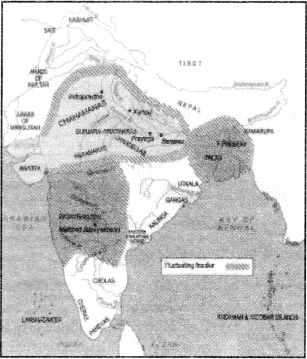New Kings and Kingdoms Class 7 Questions and Answers History Chapter 2
Class 7 History Chapter 2 NCERT Textbook Questions and Answers
Question 1.
Match the folio wing-
| Gujara-Pratiharas | Western Deccan |
| Rashtrakutas | Gujarat and Rajasthan |
| Palas | Bengal |
| Cholas | Tamil Nadu |
Answer:
| Gujara-Pratiharas | Gujarat and Rajasthan |
| Rashtrakutas | Western Deccan |
| Palas | Bengal |
| Cholas | Tamil Nadu |
Question 2.
Who were the parties involved in the “Tripartite Struggle”?
Answer:
Palas-Rashtrakutas and Pratiharas were the parties involved in the tripartite struggle.
Question 3.
What were the qualification necessary to become a member of a committee of the sabha in the Chola empire?
Answer:
Uttaramerur in Tamil Nadu give us vivid account the way in which the Sabha was organised. The Sabha had committee to look after irrigation works, garden, temples etc. Name of those who were eligible to become the member of the committees were written on small ticket of palm leaf and kept in an earthenware from which a young boy was asked to pick up tickets one by one for each committee.
Question 4.
What were the two major cities under the control of the Chahamanas?
Answer:
Delhi and Ajmer were the two major cities under the control of Chahamanas.
Question 5.
How did the Rashtrakutas become powerful?
Answer:
Dantivarman was the founder of this dynasty who rose to power in 753, in modem Maharashtra. Some other great rulers of this dynasty were Krishna-I, Govinda-III, Amoghvarsha and Indra-III.
The Rashtrakutas fought against the Chalukyas and the Pallavas in the South. The Rashtrakuta king Dhruva defeated Pratihara king Vatsarajan but he couid not retain Kanauj.
The rock-cut Kailasha Temple at Ellora was built by king Krishna-I. The Rashtrakutas maintained trade relations with foreign countries.
Regarding the religion, they patronised Saivism and Vaishnavism and also encouraged Jainism, Buddhism and Islam. They also allowed Muslim merchants to settle in their kingdoms.
Question 6.
What did the new dynasties do to gain acceptance?
Answer:
By the 17th century, there were big land lords or warrior chiefs in different regions of the subcontinent. They were known as Samants. As they gained power and wealth they declared themselves to be maha-Samanta. One such instance was that of the Rashtrakutas in Deccan. Initially they were or the Subordinate of the Chalukyas. In the mid of the 8th century Dantidurga the founder of the Rashtrakuta overthrow Chalukyas to regain power.
Question 7.
What kind of irrigation works were developed in the Tamil region?
Answer:
A variety of methods of irrigations were used in Tamil Region in medieval India”
- In some areas wells were dug out for irrigation.
- Huge tanks were constructed to store rain water. This water was used during the dry season.
Question 8.
What were the activities associated with the Chola temples?
Answer:
Activities associated with the temples”
- Chola temples were the nuclei of settlement which grew around them.
- Temples were the centres of the craft production.
- Temples were endowed with the land of the rulers as well as by others. The produce of the land went to maintain all the specialist who worked at the temple.
- Temples were not only the places of worship they were the hub of social, cultural and economic life.
Question 9.
Look at Map I once more and find out whether then were many kingdoms in the state in which you live.

Answer:
Since I am living in Delhi, it was called Indraprastha and it was ruled by Chauhan dynasty (between 11th and 12th centuries).
Question 10.
Contrast the ‘elections’ in Uttaramerur with present-day panchayat elections.
Answer:
Uttaramerur in present-day is in Tamil Nadu. It is the part of Chinglepet district. From the inscriptions found in Uttaramerur, we can say how the Sabha was formed in this village. The names of all eligible candidates (members) who wanted to be the member of the sabha were written on palm-leaf and kept in an earthem pot from which a young boy was asked to pick the tickets one by one to elect each member of the committee.
Regarding, now-a-days, election are held for the selection of the members of panchayat Nomination form are filled by the member who wants to stand for election. On the fixed day, the election are held. All the members of the village who are 18 and above can cast their votes to elect their panchayat member.
Question 11.
Compare the temple shown in this chapter with any present-day temple in your neighborhood, highlighting any similarities and differences that you notice.
Answer:
In the old days, temples were usually made of stones and rocks. Stone sculpture were used to decorate the outer walls (Example-Temple at Gangaikondacholapuram). In those days bronze image of Gods and Goddesses were considered amongst the finest in the world. The present-day temples are constructed with more better material such as marble, tiles, mirrors, etc. These constructions are more beautiful because of the latest technology available. The images of Gods and Goddesses are also made of different materials, such as gold, marble, etc.
Question 12.
Find out more about taxes that are collected at present. Are they in cash, kind, or labour services?
Answer:
Most of the taxes collected at present are mostly in cash. However, in some villages taxes are also collected in kind or labour services.